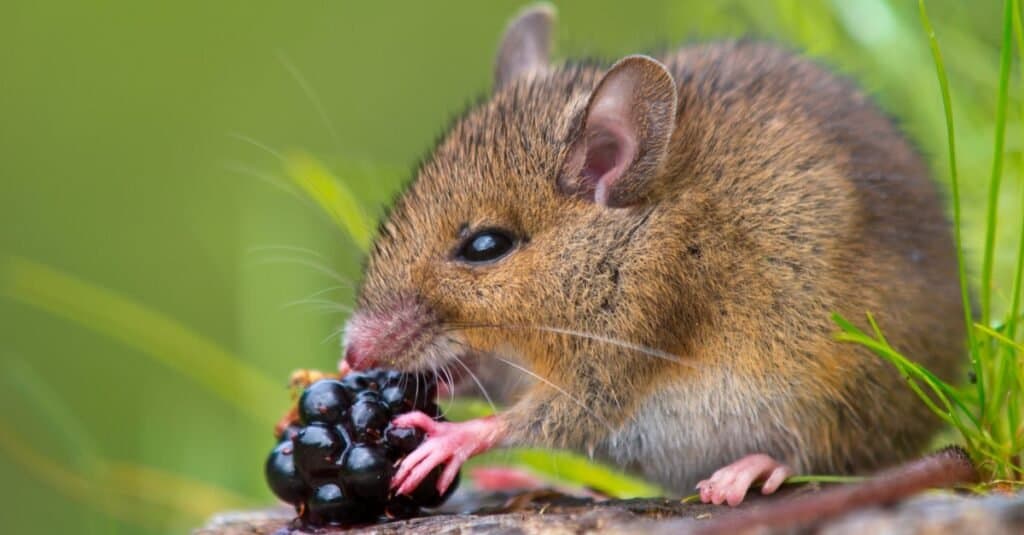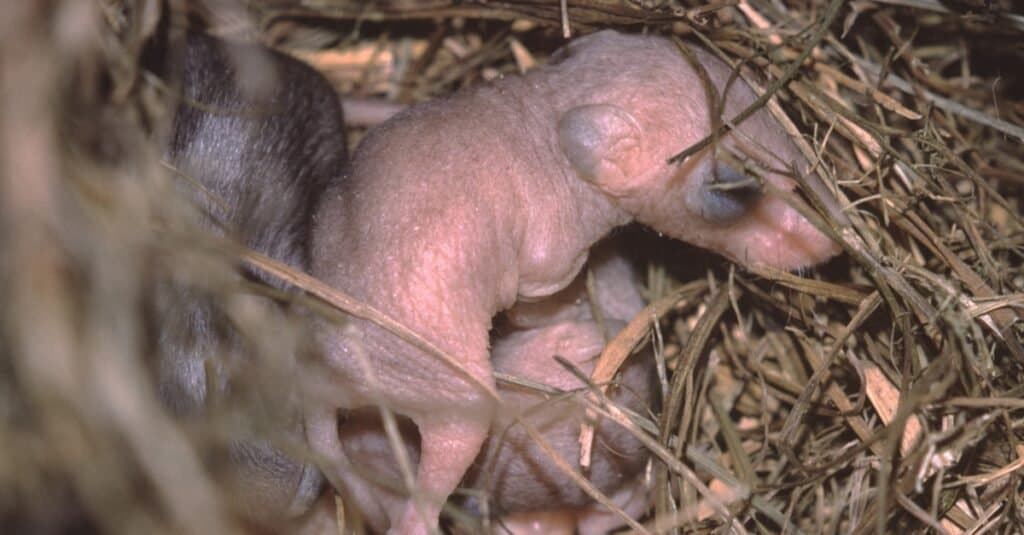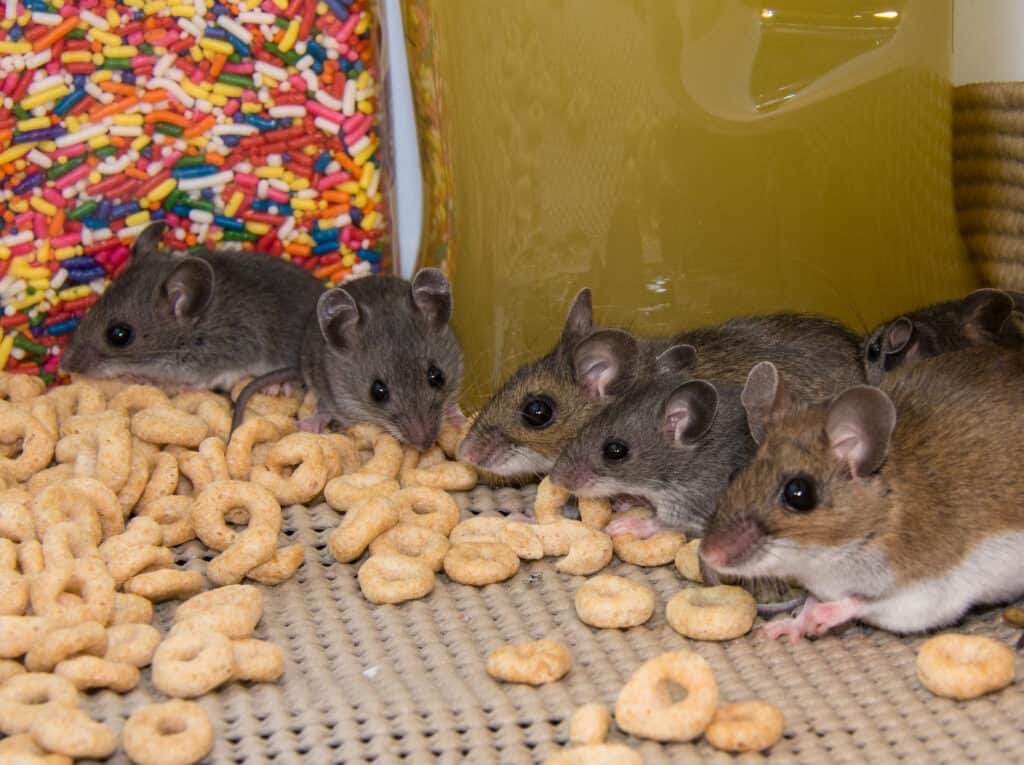Mice are interesting little creatures that tend to live in areas inhabited by humans. They love our farmlands, where they can eat tons of vegetables and wallow in our garbage to get a meal, and they enjoy our suburban homes with all our tasty kinds of oats and plants. Like many other creatures, mice build nests to house their young and stay safe when the weather becomes inhospitable. What happens if you stumble upon a nest and jostle it, though? Will mice return to a disturbed nest?
That’s what we’re going to look at today with our latest foray into topics about mice. We’ll get to the bottom of this subject and tell you what you should do if you find a nest.
Why Do Mice Need Nests?

Mice use nests to keep warm and raise their young.
©Rudmer Zwerver/Shutterstock.com
Before we examine whether mice return to their disturbed nests, we need to know why they even bother to have nests. Generally speaking, mice build nests for the same reasons as other animals. They want a place where they can keep safe and warm during cold months.
Oftentimes, their nests are made from materials that help keep the area insulated and warm. They will often steal nesting materials from human homes and outbuildings.
The other major reason that mice need a nest is to raise their young. Mice breed very quickly, so they need a nest within three weeks of breeding. The average size of a litter of mice is between 6 and 8 creatures, so they need a safe place to put all those babies.
Also, mice can start breeding again almost immediately, and their progeny will be ready to breed in 6 weeks.
What Does a Mouse Nest Look Like?

Mouse nests can look unique depending on the materials from which they’re made.
©Liz Weber/Shutterstock.com
If you didn’t know that mice made nests and this is your first time hearing about them, then you probably wonder if you have them in your home. Let’s take a look at what mouse nests look like, so you can figure out if you have any of them in your house.
Mouse nests are made from whatever materials are most available to the mouse. Sometimes, that will be grass and other types of brush. Other times, you will see that mice use paper towels, cloth, and other human-made materials to make a nest for themselves.
Mouse nests are anywhere between 3 and 6 inches in diameter, and they are circular and bushy. They’re designed to keep the mice warm and comfortable.
Mice also build their nests in different areas depending on where they’re living. For example, you can often find field mice nests in heavy overgrowths of grass where they’re safe from the sight of many predators.
However, they nest in many out-of-the-way places when they are living in the same area as humans. For example, mice often nest in basements and garages where humans don’t go much. They prefer safe, dark areas, and that often leads them to find shelter in walls and ceilings, too.
Many people don’t realize they have a severe mouse infestation until they hear the mice squeaking and scratching during the late hours of the night and early hours of the morning when they’re most active.
Now that you know what nests look like, you need to know how mice react to someone touching their nest.
Will Mice Return to a Disturbed Nest?
Yes, mice will return to a disturbed nest if it still houses their young or if the area is too comfortable for them to pass up. In other words, if you rummage through a mouse’s nest or accidentally stumble upon it and then leave it alone, the mice are not going to be discouraged.
After all, the mother’s instinct to protect her children is high, and she will go back to rescue them when it’s safe and practical. Other times, mice will have found a place that offers them much protection, and they won’t want to pass that up, either.
Then again, it depends on how soon you find the nest and how much disturbance you cause. If the nest is new and isn’t home to any young mice yet, the mice won’t go back to it in most cases. Yet, if the mouse has been working on the nest for a while or has babies living in it, the mouse will probably return.
In some cases, mice will return to the location of a completely destroyed nest if the way to it hasn’t been closed off. Mice are very practical, and they know that finding a new nesting area is risky. If a human destroys their old nest but doesn’t close off access to that place, they’ll come back.
How To Get Rid of Mouse Nests

You need to act swiftly and decisively to stop a mouse infestation from getting worse.
©Landshark1/Shutterstock.com
Knowing that mice often come back to their disturbed nests, it’s important to think about how to handle mouse nests that you find. If you don’t want these tiny rodents to make a reappearance, you need to take serious measures to quell their ability to nest safely.
Follow these instructions to learn how to get rid of mouse nests after you’ve found one.
- Put on a pair of gloves, goggles, and a mask to reduce the chance of catching diseases from mice, like hantavirus.
- Place the mouse nest in a tall container with smooth sides to prevent any mice from climbing out of it.
- Get rid of the mice in the nest by exterminating or relocating them.
- Burn the nest or otherwise dispose of it as though it was a hazardous material.
- Go back to your home and completely clean the area where the mice were living with bleach.
- Close off access to the area where the mice were living using strong materials such as metal or cement.
- Watch out for future infestations.
Using these steps, you can safely remove any mouse nest from your home and minimize the risks they pose to you. Stopping a mouse infestation is important for safety and structural reasons, so it’s best to frequently inspect your home.
So, will mice return to a disturbed nest? Yes, but you can stop them by taking an immediate and overwhelming approach to the destruction of their nests.
The photo featured at the top of this post is © Adrian Eugen Ciobaniuc/Shutterstock.com
Thank you for reading! Have some feedback for us? Contact the AZ Animals editorial team.






